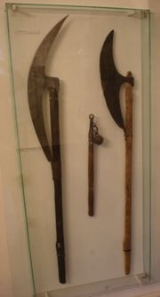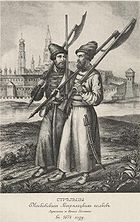
Bardiche
Encyclopedia

Glaive
A glaive is a European polearm weapon, consisting of a single-edged blade on the end of a pole. It is similar to the Japanese naginata and the Chinese Guan Dao....
polearm
Pole weapon
A pole weapon or polearm is a close combat weapon in which the main fighting part of the weapon is placed on the end of a long shaft, typically of wood, thereby extending the user's effective range. Spears, glaives, poleaxes, halberds, and bardiches are all varieties of polearms...
known in the 16th and 17th centuries in Eastern Europe and Russia. Ultimately a descendant of the medieval sparth (Danish axe
Danish axe
The Dane Axe is an early type of battle axe, primarily used during the transition between the European Viking Age and early Middle Ages. Other names for the weapon include English Long Axe, Danish Axe, and Hafted Axe.-Construction:...
), the bardiche proper appears after 1500, but there are numerous medieval manuscripts that depict very similar weapons beginning ca. 1250. The bardiche differs from the halberd
Halberd
A halberd is a two-handed pole weapon that came to prominent use during the 14th and 15th centuries. Possibly the word halberd comes from the German words Halm , and Barte - in modern-day German, the weapon is called Hellebarde. The halberd consists of an axe blade topped with a spike mounted on...
in having neither a hook at the back nor a spear point at the top.
Use of bardiches started in early 15th century Russia (some sources name the late 14th century),
and in Scandinavia in the late 15th century.
In the 16th century the bardiche became a weapon associated with streltsy
Streltsy
Streltsy were the units of Russian guardsmen in the 16th - early 18th centuries, armed with firearms. They are also collectively known as Marksman Troops .- Origins and organization :...
(Russian guardsmen armed with firearms).
Description
The blade varied greatly in shape, but was most often a long, cleaver type blade. The distinction was in how the blade was attached to the pole. The bardiche blade was attached to the pole either via two sockets (one at the top of the pole and one lower, at the base of the blade) or one socket at the top and one surface mount at the base, effectively mounting the heavy blade to the wooden shaft. This construction is also seen in Scottish polearms, such as the Lochaber axeLochaber axe
The Lochaber axe was a halberd that came into use in Scotland around 1300. The name of the weapon derives from Lochaber, an area in the western Scottish Highlands, as the weapon was employed principally by the Scottish highlanders, who required armament against cavalry.The axe itself is similar to...
and Jeddart staff, and bardiches are known to have been imported into Scotland in the 16th and 17th centuries
Depending on the design of the particular weapons in question, at times a bardiche may greatly resemble a voulge
Voulge
thumb|VoulgesA voulge is a type of polearm that existed alongside the similar glaive in medieval Europe. Superficially, a voulge might strongly resemble a glaive, but there are some notable differences in construction...
.
While the blade was often very long for an axe
Axe
The axe, or ax, is an implement that has been used for millennia to shape, split and cut wood; to harvest timber; as a weapon; and as a ceremonial or heraldic symbol...
(usually exceeding 2 feet (60 cm)) the shaft was one of the shortest of all polearms; rarely did it exceed 5 feet (1.5 m) in length. It relied more on the weight of its heavy blade to do the damage than a swing from a long pole. This makes the bardiche more similar to the Danish axe
Danish axe
The Dane Axe is an early type of battle axe, primarily used during the transition between the European Viking Age and early Middle Ages. Other names for the weapon include English Long Axe, Danish Axe, and Hafted Axe.-Construction:...
, in some respects, than to a true polearm.
Use

Streltsy
Streltsy were the units of Russian guardsmen in the 16th - early 18th centuries, armed with firearms. They are also collectively known as Marksman Troops .- Origins and organization :...
(literally 'shooters')corps (foot, mounted and dragoons) and also for the Polish infantry (shorter version invented by king Jan III Sobieski).
In Popular Media
Bardiche was also a weapon used famously by Fate TestarossaFate Testarossa
, also known as in A's epilogue and StrikerS, is a fictional character in the anime series Magical Girl Lyrical Nanoha. She is voiced by Nana Mizuki....
in the popular anime Mahou Shoujo Lyrical Nanoha
Magical Girl Lyrical Nanoha
is an anime television series directed by Akiyuki Shinbo, with screenplay written by Masaki Tsuzuki, and produced by Seven Arcs. It forms part of the Magical Girl Lyrical Nanoha series. The Japanese Association of Independent Television Stations broadcast thirteen episodes between October and...
. Not only does the weapon (referred to in the anime as a "Magical device") look similar to its namesake, it is also named after it entirely. The weapon, Bardiche, retains the original appearance of a Bardiche but also appears as a Glaive, a two-handed sword, and two one-handed swords that Fate dual-wields throughout the seasons.

